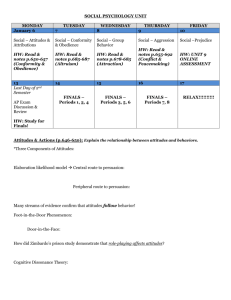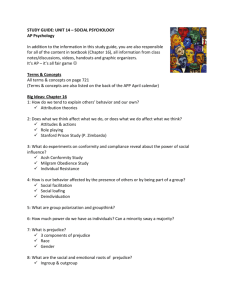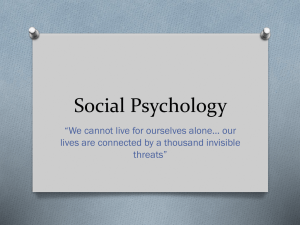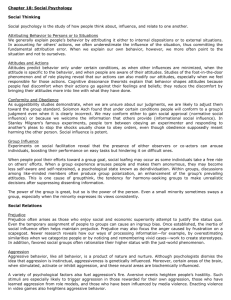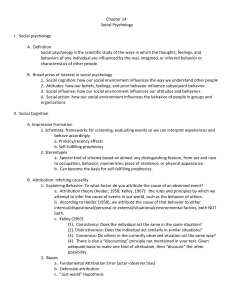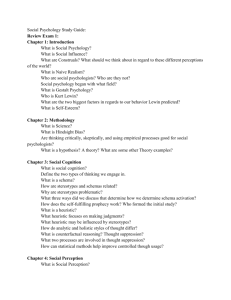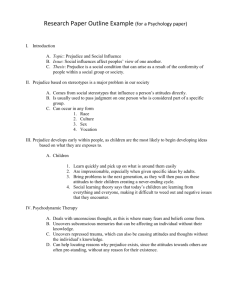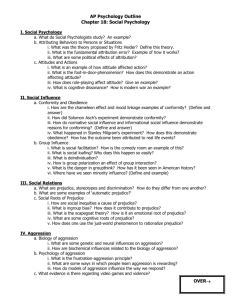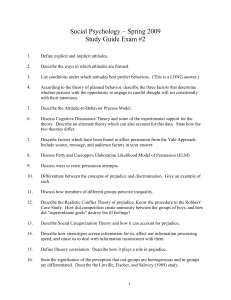Social Psychology
advertisement
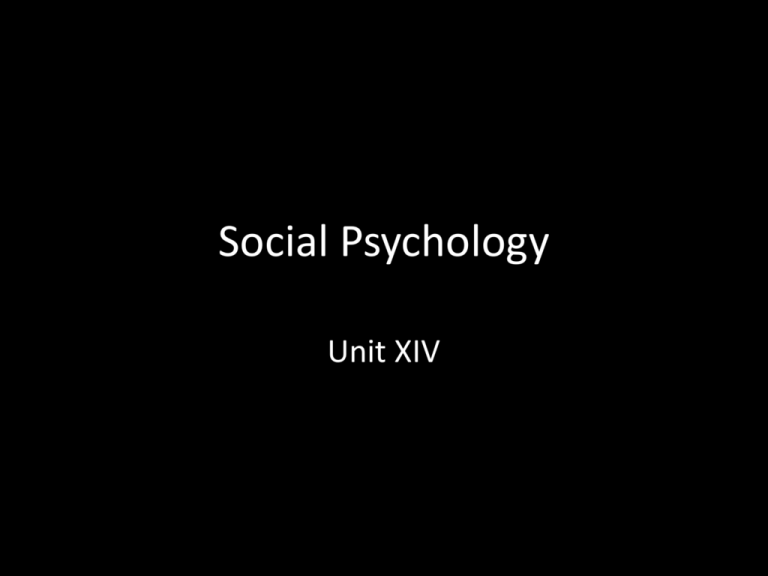
Social Psychology Unit XIV Social Psychology • Social Psychology- the scientific study of how we think about, influence, and relate to one another • Social psychologists focus on the situation • Personality psychologists focus on the person • Social psychologists will study the social influences that explain why the same person will act differently in different situations * Fundamental Attribution Error • Our social behavior comes from our social cognition • Attribution theory- the theory that we explain someone’s behavior by crediting either the situation or the person’s disposition • We can attribute the behavior to the person’s stable, enduring traits(a dispositional attribution) or we can attribute it to the situation(a situational attribution) * Fundamental Attribution Error • Example: We notice that Susan does not talk much in class and Joe talks nonstop at the game. We assume that Susan is shy and Joe is outgoing. • These attributions can be valid because people do have enduring personality traits • Sometimes we make a mistake in judging someone based on the fundamental attribution theory – The tendency for observers, when analyzing others’ behavior, to underestimate the impact of the situation and to overestimate the impact of personal disposition * Fundamental Attribution Error • People in individualistic Western cultures fall to the fundamental attribution error more than people in East Asian cultures • Western cultures more often attribute behavior to people’s personal traits while East Asian cultures are more sensitive about the impact of the situation • When judging our own behavior we take into account the impact of our situation more than we do when judging the behavior of others * Attitudes and Actions • Attitudes- feelings, often influenced by our beliefs, that predispose us to respond in a particular way to objects, people, and events • If we believe someone is threatening us, we may feel fear and anger toward the person and act defensively • Our attitudes affect our actions, and our actions affect our attitudes * Attitudes and Actions • When trying to persuade people to think a certain way or have a certain attitude about something people usually will use one of two forms of persuasion: – Peripheral route persuasion- occurs when people are influenced by incidental cues, such as a speaker’s attractiveness • Does not engage in systematic thinking, but does produce fast results as people respond to incidental cues and make snap judgments – Central route persuasion- occurs when interested people focus on the arguments and respond with favorable thoughts • Occurs mostly when people are naturally analytical and involved in the issue • It is more durable and more likely to influence behavior * Attitudes and Actions • Those who attempt to persuade us are trying to influence our behavior by changing our attitudes • Attitudes are especially likely to affect behavior when external influences are minimal, and when the attitude is stable, specific to the behavior, and easily recalled • Persuasion changes attitudes, which changes behavior * Attitudes and Actions • Not only will people stand up for what they believe, they also will believe more strongly in what they have stood up for • Some evidence from research confirms that attitudes follow behavior • Foot-in-the-door phenomenon- the tendency for people who have first agreed to a small request to comply later with a larger request * Attitudes and Actions • To get people to agree to something big, start small and build • A trivial act makes the next act easier • Succumb to a temptation, and you will find the next temptation harder to resist • In experiments, it has been seen that after speaking or writing on behalf of a position someone has problems with, they begin to believe their own words • The foot in the door phenomenon can work with bad deeds and good deeds equally • Moral action strengthens moral convictions • This was seen after the Civil Rights Act of 1964 was passed and schools were desegregated * Attitudes and Actions • Role- a set of expectations about a social position, defining how those in the position ought to behave • When you adopt a new role you strive to follow the social prescriptions for that role • At first your behaviors may feel phony because you are acting a role • Before long the behavior becomes you • Role playing morphed into real life in the Stanford Prison experiment * Attitudes and Actions • Cognitive dissonance theory- the theory that we act to reduce the discomfort(dissonance) we feel when two of our thoughts(cognitions) are inconsistent – For example- we become aware that our attitudes and our actions clash, we can reduce the resulting dissonance by changing our attitudes – We cannot directly control all our feelings, but we can influence them by altering our behavior – Changing our behavior can change how we think about others and how we feel about ourselves * Conformity: Complying with social pressures • Behavior is contagious • If one of us yawns, laughs, coughs, stares at the sky, or checks a cell phone, others in our group will soon do the same • We take on the emotional tones of those around us • We are natural mimics, unconsciously imitating others’ expressions, postures, and voice tones * Conformity: Complying with social pressures • Chameleon effect- the mimicry humans show in doing the same as others around them • Automatic mimicry helps us to emphasize- to feel what others are feeling • Conformity- adjusting our behavior or thinking to coincide with a group standard • Suggestibility and mimicry are types of conformity * Conformity: Complying with social pressures • Solomon Asch performed experiments to study conformity • We are more likely to conform when we: – – – – – – Are made to feel incompetent Are in a group with at least three people Are in a group which everyone else agrees Admire the group’s status and attractiveness Have not made a prior commitment to any response Know that others in the group will observe our behavior – Are from a culture that strongly encourages respect for social standards * Conformity: Complying with social pressures • We frequently conform to avoid rejection or to gain social approval • Normative social influence- influence resulting from a person’s desire to gain approval or avoid disapproval • We are sensitive to social norms because the price we pay for being different can be severe • We need to belong and to get along, so we decide to go along * Conformity: Complying with social pressures • At other times, we conform because we want to be accurate • Groups provide information, and only stubborn people will never listen to others • Informational social influence- influence resulting from one’s willingness to accept others’ opinions about reality • Sometimes it pays to assume others are right and to follow their lead * Obedience: Following orders • Stanley Milgram studied obedience • Milgram discovered that obedience was at its highest when: – The person giving the orders was close at hand and was perceived to be a legitimate authority – The authority figure was supported by a prestigious institution – The victim was depersonalized or at a distance – The were no role models for defiance * Obedience: Following orders • The power of legitimate, close at hand authorities was apparent among those who followed orders to carry out the Holocaust • In 1942, 500 German police officers were sent to round up a village of Jews, who were said to be aiding the enemy • All the able-bodied men would be sent to work camps, and all the rest would be shot on the spot • The commander gave the officers a chance to refuse to participate in the executions but only about a dozen refused • The remaining 485 officers killed 1500 woman, children, and elderly • Seeing the results, some 20 percent of the officers did dissent, managing either to miss their victims or to wander away and hide until the slaughter was done * Obedience: Following orders • Strong social influences can make people conform to falsehoods or participate in cruelty • In any society, great evils sometimes grow out of people’s compliance with lesser evils • Cruelty does not require devilish villains • All it takes is ordinary people corrupted by an evil situation * Social Facilitation • Social facilitation- improved performance on simple or well-learned tasks in the presence of others • On tougher tasks, people perform worse when observers or others working on the same task are present • The presence of others sometimes helps and sometimes hinders performance • When others observe us, we become aroused, and this arousal amplifies our other reactions * Social Facilitation • The presence of others strengthens our most likely response- the correct one on easy task, an incorrect one on a difficult task • Pool players who made 71 percent of their shots alone, made 80 percent when four people were watching • Poor shooters who made 36 percent of their shots when alone, made only 25 percent when watched * Social Facilitation • What you do well, you are likely to do even better in front of an audience, especially a friendly audience • What you normally find difficult may seem all but impossible when you are being watched * Social loafing • Social facilitation looks at the effect of others’ presence on performance on an individual task • What happens to performance when people perform the task as a group? • Would your effort be more or less when working in group compared to when you work alone? * Social loafing • Social Loafing- the tendency for people in a group to exert less effort when pooling their efforts toward attaining a common goal than when individually accountable – People acting as part of a group feel less accountable, and therefore worry less about what others think – Group members may view their individual contributions as dispensable – When group members share equally in the benefits some may slack off • Unless highly motivated and strongly identified with the group, people may free ride on others’ efforts * Deindividuation • Sometimes the presence of others can arouse people and it can diminish their feelings of responsibility- social facilitation and social loafing • Deindividuation- the loss of self-awareness and self-restraint occurring in group situations that foster arousal and anonymity • For example food fights or vandalism * Deindividuation • In one experiment one group of women were dressed in KKK hoods and the other group did not where any disguise • The ones wearing the hoods delivered twice as much electric shock to a victim * Group polarization • The beliefs and attitudes we bring to a group grow stronger as we discuss them with like minded others • Group polarization- the enhancement of a group’s prevailing inclinations through discussion within the group • Group polarization can feed extremism and even suicide terrorism * Group polarization • As the terrorist groups interact in isolation their views grow more and more extreme • Increasingly they categorize the world as us against them • The internet has helped to speed up the process of group polarization in good ways and in bad ways * Groupthink • Group interaction can influence our personal decisions • Sometimes group members will suppress or self-censor their dissenting views in order to preserve the good feeling of the group • Groupthink- the mode of thinking that occurs when the desire for harmony in a decisionmaking group overrides a realistic appraisal of alternatives * Groupthink • Groupthink- fed by overconfidence, conformity, self-justification, and group polarizationcontributed to the attacks at Pearl Harbor, the Vietnam War, and the Watergate scandal • Despite the dangers of groupthink, two heads are better than one in solving many problems • The suppression of dissent bends a group toward bad decisions, open debate often shapes good ones * Power of the individual • Even with all the social control that is exerted on individuals, individuals are still in control of their actions • When feeling coerced, we may react by doing the opposite of what is expected, thereby reasserting our sense of freedom • Committed individuals can even sway the majority * Power of the individual • The power of one or two individuals to sway majorities is minority influence • When you are the minority, you are far more likely to sway the majority if you hold firmly to your position and don’t waffle * Cultural influences • Humans come equipped with a huge cerebral cortex ready to receive information necessary for survival • Culture- the enduring behaviors, ideas, attitudes, values, and traditions shared by a group of people and transmitted from one generation to the next • Culture supports our species’ survival and reproduction by enabling social and economic systems that give us an edge • Even though cultures differ throughout the world, all humans are connected in their capacity for culture * Cultural influences • Humans in varied cultures share some basic moral ideas • Norms- an understood rule for accepted and expected behavior • Norms prescribe proper behavior • When cultures collide there are often conflicts with norms • When we don’t understand what’s expected or accepted, we may experience culture shock * Prejudice • Prejudice- an unjustifiable and usually negative attitude toward a group and its members • Prejudice generally involves stereotyped beliefs negative feelings, and a predisposition to discriminatory action • The attitudes are usually toward a different cultural, ethnic, or gender group * Prejudice • Prejudice has three parts: – Beliefs • Stereotypes- a generalized, sometimes accurate but often overgeneralized, belief about a group of people – Emotions – Predispositions to action • To discriminate • Discrimination- unjustifiable negative behavior toward a group and its members * Prejudice • When some people have money, power, and prestige and other do not, the “haves” usually develop attitudes that justify things as they are • Just-world phenomenon- the tendency for people to believe the world is just and that people therefore get what they deserve and deserve what they get * Prejudice • Just-world phenomenon reflects an idea that good is rewarded and bad is punished • From there people assume that those who succeed must be good and those who suffer must be bad * Prejudice • Ingroup- Us- people with whom we share a common identity • Outgroup- them- those perceived as different or apart from our ingroup • Ingroup bias- the tendency to favor our own group – Example would be ethnocentrism * Prejudice • The urge to distinguish enemies from friends predisposes prejudice against strangers • Most students believe their school is better than all other schools around • Even chimps have been seen to wipe clean the spot where they were touched by a chimp from another group * Prejudice • Scapegoat theory- the theory that prejudice offers an outlet for anger by providing someone to blame • Following 9/11 some outraged people lashed out at innocent Arab-Americans • Students who experience failure or are made to feel insecure often restore their self-esteem by talking bad about a rival school or another person * Prejudice • Negative emotions nourish prejudice • When facing death, fearing threats, or experiencing frustration, people cling more tightly to their ingroup and their friends • As the terror of death heightens patriotism, it also produces loathing and aggression toward “them” Prejudice • We simplify our world by creating categories • People categorize people by race, gender, or other cultural characteristics • In categorizing people into groups we often stereotype them • We recognize how greatly we differ from other individuals in our groups • To those in one ethnic group, members of another often seem more alike than they really are in attitudes, personality, and appearance * Prejudice • Other-race effect- the tendency to recall faces of one’s own race more accurately than faces of other races • With effort and with experience, people get better at recognizing individual faces from another group * Aggression • Aggression- any physical or verbal behavior intended to hurt or destroy • Aggressive behavior emerges from the interaction of biology and experience • Aggression varies too widely from culture to culture to be an unlearned behavior • Biology does influence aggression though • Genetic influences, neural influences, and biochemical influences can all impact a person’s aggression * Aggression • Frustration-aggression principle- the principle that frustration creates anger, which can generate aggression • Frustration caused by the blocking of an attempt to achieve some goal • Aversive stimuli can also evoke hostility • Some examples of aversive stimuli: hot temperatures, physical pain, personal insults, foul odors, crowding * Aggression • Parents can serve as an aggression model by their behaviors • TV shows, films, video games, and other forms of media can also serve as models for aggression • Social scripts- culturally modeled guide for how to act in various situations • When we find ourselves in new situations, we use social scripts to help us figure out how to behave * The psychology of attraction • We constantly wonder how we can win others’ affection and what makes our own affections flourish or fade • Proximity(geographic nearness) is friendship’s most powerful predictor • Proximity provides opportunities for aggression, but much more often it breeds liking • Studies have shown that people are more likely to marry those that live in the same neighborhood, set nearby in class, who work in the same office, or are in some other way in close proximity * The psychology of attraction • Mere exposure effect- the phenomenon that repeated exposure to novel stimuli increases liking of them • We are even somewhat more likely to marry someone whose first and last name resembles our own • Familiarity can breed fondness • Some studies have shown that people like other people when their faces incorporate some morphed features of their own * Romantic Love • Passionate love- an aroused state of intense positive absorption in another, usually present at the beginning of a love relationship • The two-factor theory of emotion can help us understand this intense positive absorption in another – The theory assumes that emotions have two ingredients- physical arousal and cognitive arousal – The theory also assumes that arousal from any source can enhance one emotion or another, depending on how we interpret and label the arousal * Romantic Love • In one study, college men were aroused by fright, by running in place, or by listening to humorous or repulsive monologues • They were then asked to rate an attractive woman • Unlike unaroused men, the stirred up men attributed some of their arousal to the woman, and felt more attracted to her * Romantic Love • The intense absorption in the other typically fades with time • As love matures, it becomes a steadier companionate love • Companionate love- the deep affectionate attachment we feel for those with whom our lives are intertwined • The flood of passion-facilitating hormones subsides and another hormone called oxytocin supports feelings of trust, calmness, and bonding with the mate * Romantic Love • One key to a gratifying and enduring relationship is equity • Equity- a condition in which people receive from a relationship in proportion to what they give to it • When equity exists their chances for sustained and satisfying companionate love are good * Romantic Love • Another key ingredient of loving relationships is self-disclosure • Self-disclosure- revealing intimate aspects of oneself to others • Self-disclosure breeds liking, and liking breeds self-disclosure * Altruism • Altruism- unselfish regard for the welfare of others • Altruism became a major concern for social psychologists after the case of Kitty Genovese • In 1964, a stalker repeatedly stabbed her then raped her as she lay there dying outside her apartment • 38 neighbors witnesses heard her screaming • Her attacker even fled and then returned to stab and rape her again • Not until he fled for good did anyone come to her aid * Altruism • Most commentators about the stabbing and rape were outraged by the bystanders apathy and indifference about the crime • Social psychologists attributed their inaction to the presence of others • The social psychologists believed most of us would have acted the same way put in the same situation • The psychologists performed experiments that led to their idea of: we will help if the situation enables us first to notice the incident, then to interpret it as an emergency, and finally to assume responsibility for helping • At each step, the presence of others can turn us away from the path that leads to helping * Altruism • Bystander effect- the tendency for any given bystander to be less likely to give aid if other bystanders are present • Research has shown that the best odds for our helping someone occur when: – – – – – – – – – The person appears to need and deserve help The person is in some way similar to us The person is a woman We have just witnessed someone else being helpful We are not in a hurry We are in a small town or rural area We are feeling guilty We are focused on others and not preoccupied We are in a good mood * Altruism • One widely accepted view of why we help is that self-interest underlies all human interactions, that our constant goal is to maximize rewards and minimize costs • Social exchange theory- the theory that our social behavior is an exchange process, the aim of which is to maximize benefits and minimize costs • If you are trying to decide if you should give blood or not you may weigh the costs of time and discomfort against the benefits of reduced guilt or social approval * Altruism • Other people believe we help because we have been socialized to do so, through norms that prescribe how we ought to behave • Reciprocity norm- an expectation that people will help, not hurt, those who have helped them • This promotes us to give about as much as we have received * Altruism • Social-responsibility norm- an expectation that people will help those needing their help • For example, young children and others who cannot give as much as they receive * Conflict and peacemaking • Conflict- a perceived incompatibility of actions, goals, or ideas • Conflict usually produces results no one wants • Social traps- a situation in which the conflicting parties, by each rationally pursuing their self-interest rather than the good of the group, because caught in mutually destructive behavior * Conflict and peacemaking • Mirror-image perceptions- mutual views often held by conflicting people, as when each side sees itself as ethical and peaceful and views the other side as evil and aggressive • Mirror-image perceptions often feed a vicious cycle of hostility • Self-fulfilling prophecies- a belief that leads to its own fulfillment * Conflict and peacemaking • Superordinate goals- shared goals that override differences among people and require their cooperation • GRIT- Graduated and Reciprocated Initiatives in Tension Reduction- a strategy designed to decrease international tensions *
